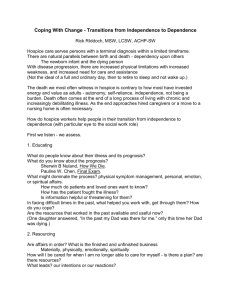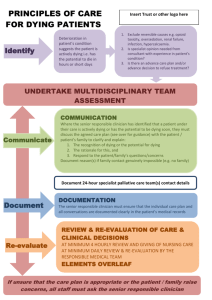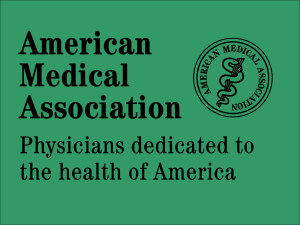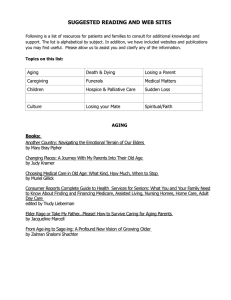End of Life (EOL) Learning objective 1. Define palliative care.
advertisement
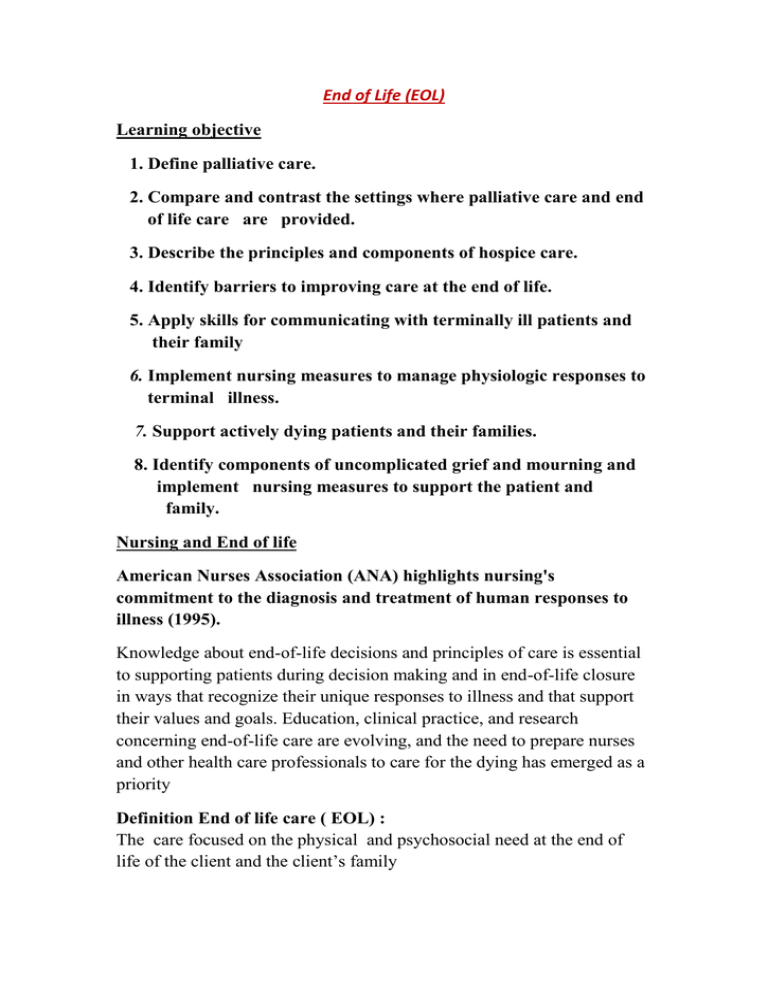
End of Life (EOL) Learning objective 1. Define palliative care. 2. Compare and contrast the settings where palliative care and end of life care are provided. 3. Describe the principles and components of hospice care. 4. Identify barriers to improving care at the end of life. 5. Apply skills for communicating with terminally ill patients and their family 6. Implement nursing measures to manage physiologic responses to terminal illness. 7. Support actively dying patients and their families. 8. Identify components of uncomplicated grief and mourning and implement nursing measures to support the patient and family. Nursing and End of life American Nurses Association (ANA) highlights nursing's commitment to the diagnosis and treatment of human responses to illness (1995). Knowledge about end-of-life decisions and principles of care is essential to supporting patients during decision making and in end-of-life closure in ways that recognize their unique responses to illness and that support their values and goals. Education, clinical practice, and research concerning end-of-life care are evolving, and the need to prepare nurses and other health care professionals to care for the dying has emerged as a priority Definition End of life care ( EOL) : The care focused on the physical and psychosocial need at the end of life of the client and the client’s family The goals for care are to 1. Provide comfort and supportive care during the dying process 2. Improve the quality of the remaining life 3. Help ensure a dignified death Glaser and Strauss (1965) discovered that health care professionals in hospital settings avoided direct communication about dying in hope that the patient would discover it on his or her own. They identified four "awareness contexts," described as the patient's, physicians, families, and other health care professionals' awareness of the patient's status and their recognition of each other's awareness: * Closed awareness: The patient is unaware of his or her terminal state while others are aware. * Suspected awareness: The patient suspects what others know and attempts to find out. * Mutual pretense awareness: The patient, the family, and the health care professionals are aware that the patient is dying but all pretend otherwise. *Open awareness: All are aware that the patient is dying and are able to openly acknowledge that reality. PALLIATIVE CARE AND HOSPICE Palliative care is health care concept which aimed at symptom management rather than curative treatment for diseases that no longer respond to treatment . Palliative care is focused on caring interventions rather than curative treatments. Palliative care is pain-control and symptom-control with and providing proper environment with psychosocial support. Palliative care is the framework for hospice care Hospice care is associated with the end of life, and although it focuses on quality of life, hospice care usually includes realistic emotional, social, spiritual, arid financial preparation for death. It is clear that better care for the dying is urgently needed in hospitals, long-term care facilities, home care agencies, and outpatient settings. At the same time, many chronic diseases do not have a predictable "end stage" that fits hospice eligibility criteria, meaning that many patients die after a long, slow, and often painful decline, without the benefit of the coordinated palliative care that is unique to hospice programs. Treatments deficiencies in the care of the dying in hospital settings: - Many patients received unwanted care at the end of life. - Clinicians were not aware of patient preferences for life- sustaining treatment, even when preferences were documented in the clinical record. - Pain was often poorly controlled at the end of life. - Efforts to enhance communication were ineffective. Principles underlying hospice are as follows: - Death must be accepted. - The patient's total care is best managed by an intend team whose members communicate regularly with such client - Pain and other symptoms of terminal illness managed. - The patient and family should be viewed as a sing care. - Home care of the dying is necessary. - Bereavement care must be provided to family member - Research and education should be ongoing.
